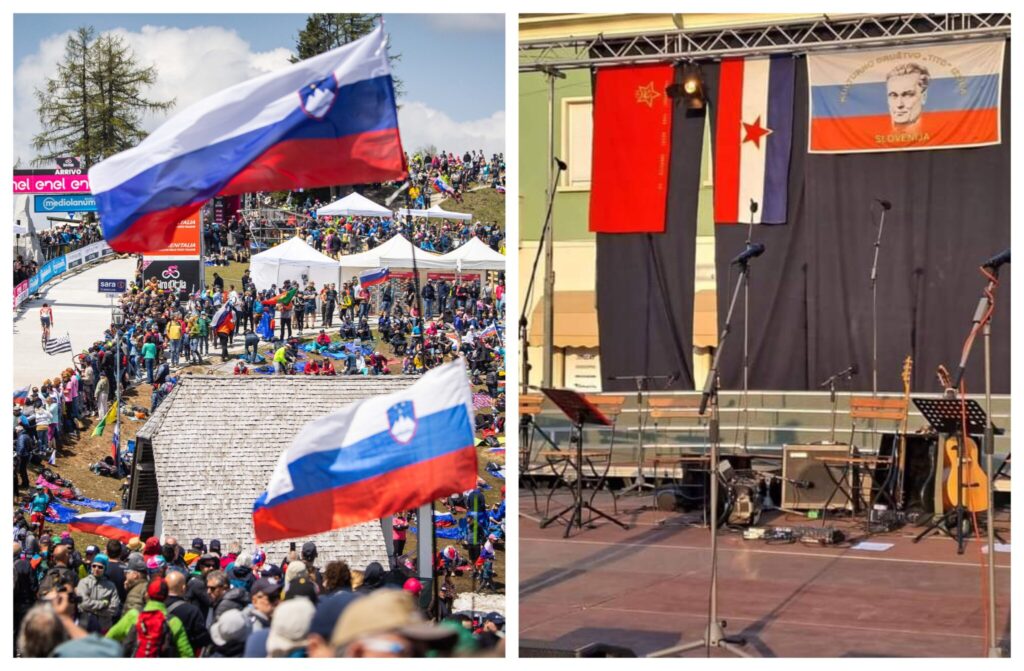Despite the fact that Svete Višarje (Monte Santo di Lussari) lie on the border with Italy, on Saturday, the 27th of May, they became completely Slovenian for one day. There were many white, blue and red flags flying in the air, and Slovenian language could be heard at every turn, and to make the day complete, our cycling champion Primož Roglič made it perfect with an incredible win in Saturday’s climbing time trial. And while Slovenia today has more than enough reasons to celebrate important moments that are writing our new history, some people are still pathologically obsessed with glorifying and celebrating the previous regime.
Svete Višarje became the centre of cycling for Slovenians on Saturday, at least for one day. Proud of our cycling ace Primož Roglič, Slovenian fans waved Slovenian flags, and the whole thing was like a big cycling Planica. His victory symbolically took place right where Dr Lambert Ehrlich was contemplating an independent Slovenia in 1933, and just one day after the anniversary of his assassination.
Primož Roglič’s victory was greeted by thousands of Slovenian fans who were on site. Roglič then also became the winner of the Tour of Italy. On the penultimate stage of the Giro, he beat Geraint Thomas with a remarkable ride, despite a bike failure at the decisive moment, thus taking the famous pink jersey. The 33-year-old from Kisovec near Zagorje had lots of support during the chronometer part of the race to Svete Višarje. At the start in Trbiž and all the way to the finish line, he was cheered on by many of his compatriots who had made the journey to the Italian-Slovenian border. Only 3,000 ticket holders could make it to the top, but supporters filled the corners along the road to the famous shrine of the Mother of God of Višarje.
Fanning the flames of the civil war
And while on the one hand, we have proud Slovenians celebrating the moments that made Slovenian history, on the other hand, we keep going back, or rather, we still have one foot in the Yugoslavian era, and on certain days we commemorate the communist dictators. Just like every year, an event to mark the “Youth Day” took place in Izola this year, too. The day is dedicated to the Tito-nostalgics, as it is supposed to celebrate Tito’s birth on the 25th of May, although Tito was actually born on the 7th of May. And yet, his portrait was fluttering on the stage next to flags with a red star. Svetlana Makarovič, who cannot come to terms with Slovenia’s independence and Slovenian national symbols, was, of course, also present – right there in the front row.
When comparing one photo with the other, the disparity is more than obvious, and any doubts about which situation is better suited to fame are dispelled. A young cycling ace, the hope of Slovenia, or a criminal and a dictator. The “Youth Day,” or rather the day of “Tito’s Relay of Youth” (the 25th of May), is, above all else, an extremely opportune moment for a sober reflection on Tito’s personality and the attitude of his followers towards it. Despite the fact that a number of books have been written about him as a successful commander of the partisan army, songs have been written about him, and many films have been made, the worship of his personality has turned into a myth (a fictional fairy tale), and what is most ironic here is that the Slovenian left is constantly talking about some kind of progressiveness and advancement, while it is clear that it is not only behind the times, but is practically still where it was more than thirty years ago.
Tanja Brkić


